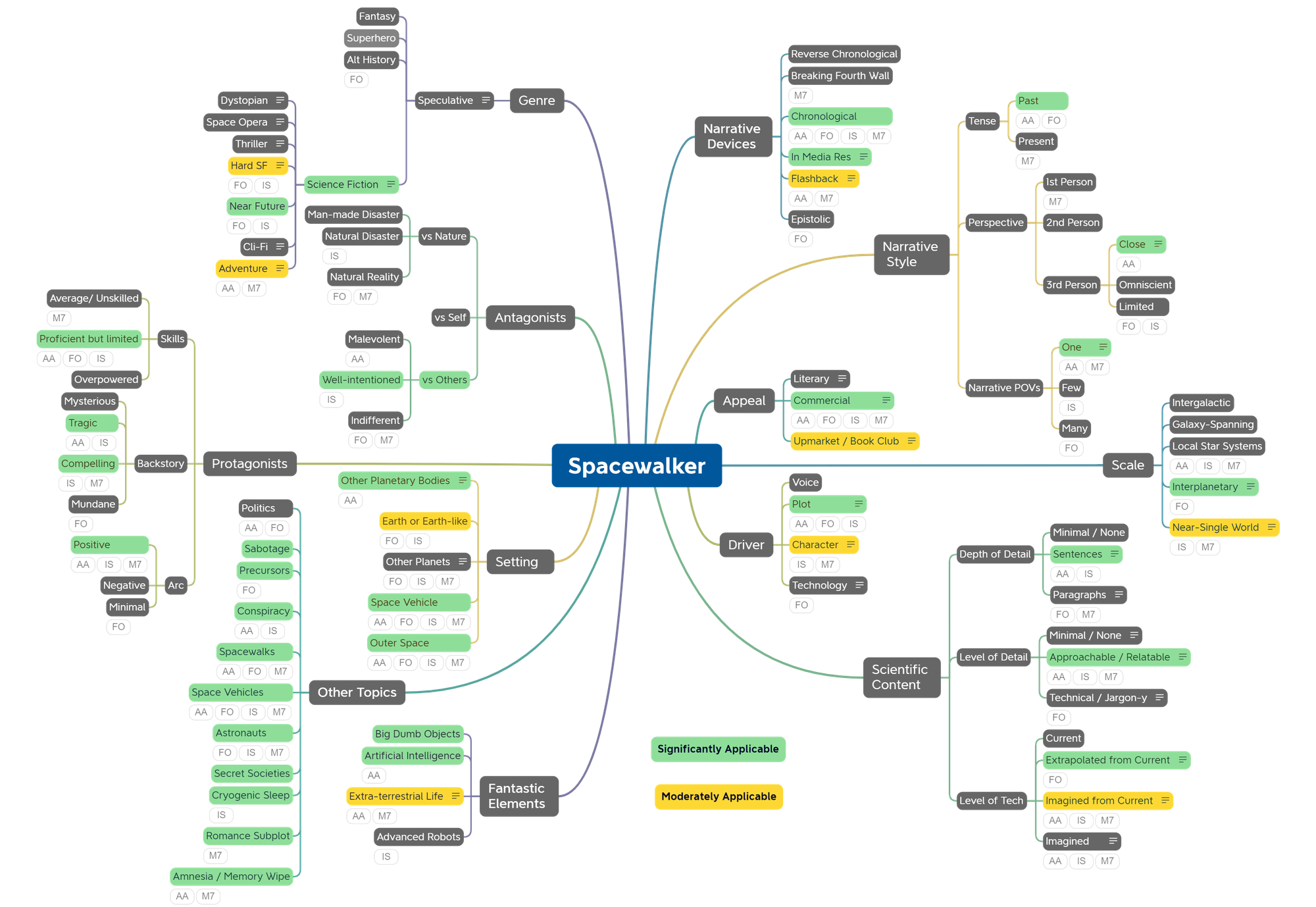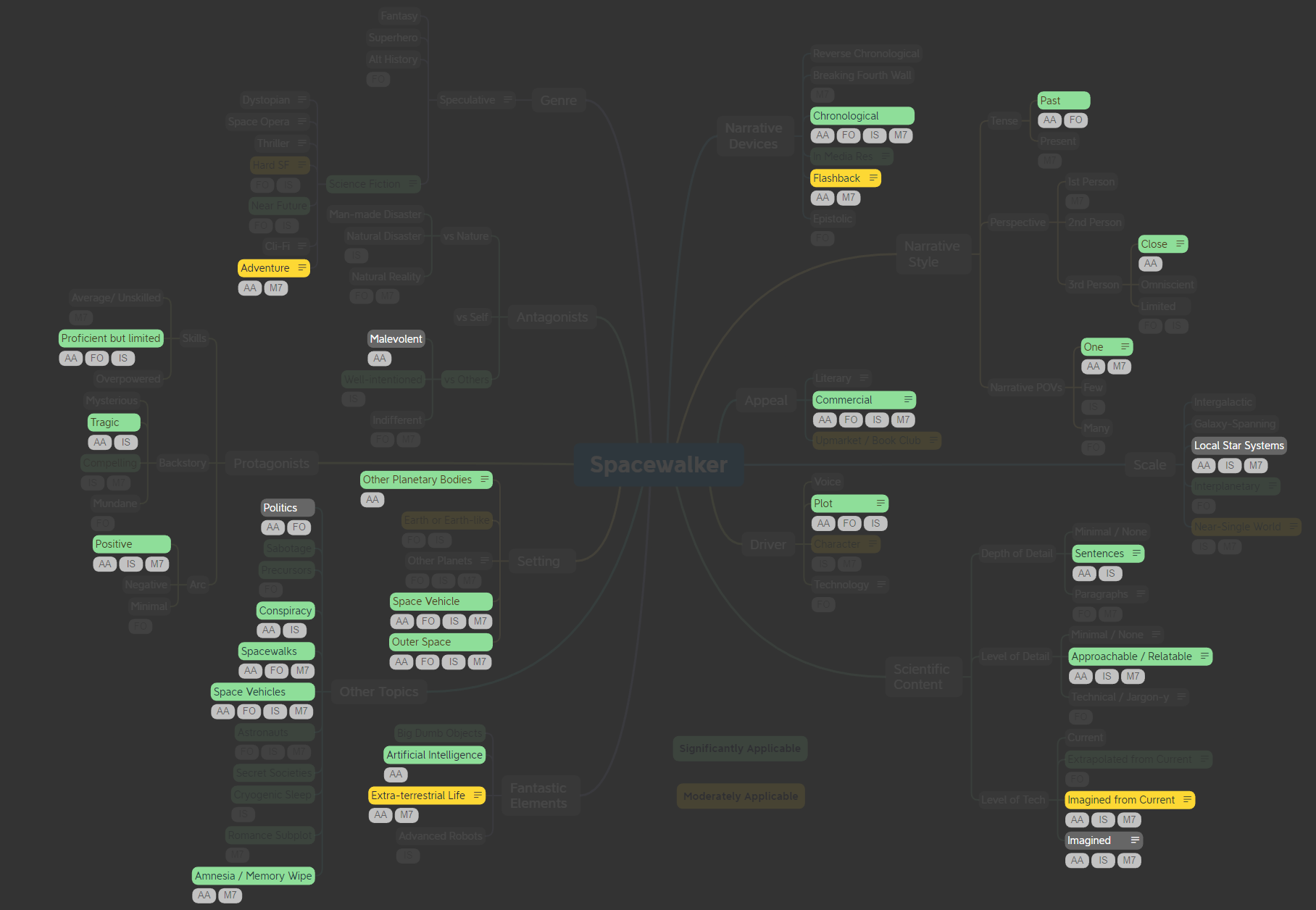Story Taxonomy: Comparisons
I developed a Story Taxonomy diagram in Xmind to better understand how my novel, Spacewalker fit into the literary landscape. Since then, I've begun using this diagram to compare and contrast what I've written against some of the science fiction I've read recently.
Here's a comparison diagram including Frozen Orbit (FO) by Patrick Chiles, Mickey7 (M7) by Edward Ashton, Finder (AA) by Suzanne Palmer, and the movie Interstellar (IS).

As a reminder, after I broke down each of the major taxonomy topics, I color coded them for applicability with my novel. Green is significantly applicable while yellow is moderately applicable. In order to do the comparison, I assessed each science fiction work against each category and added a tag to indicate applicability.
(As a very long aside, I tried to pick two character label names to represent each work. I ended up stuck when it came time to chart Finder. FI? FR? Both sort of blended in with Frozen Orbit's FO. I thought about using the main character's name as a stand-in, but alas, Fergus Ferguson--FF--doesn't help one bit. I settled for AA.)
All the labels definitely make for a messier diagram. But here's what it looks like when filtered just for Finder.

And, as a very crude method of relative comparison, I used a count of attributes to derive a percentage of similarity.
| Title | Green | Yellow | Gray | Similarity |
| Spacewalker | 34 | 9 | 0 | 100% |
| Interstellar (IS) | 15 | 5 | 7 | 76% |
| Frozen Orbit (FO) | 14 | 2 | 13 | 55% |
| Mickey7 (M7) | 13 | 6 | 10 | 66% |
| Finder (AA) | 19 | 4 | 4 | 85% |
At a glance this works fine, but I'm a bit limited by the format I've chosen for myself. If I mess with this idea further (I probably won't), I'll start by exporting this diagram content to Excel. From there I could score the comparisons on a more granular level, for instance, by applying the Significant vs Moderate applicability scale. I'd also like to use some kind of weighting system to count some characteristics as more important than others. Under the current scheme, each item is weighted equally; clearly the incorporation of "Big Dumb Objects" is less important than being the same sub-genre!
Speaking of "weighting," this exercise helped me to intuit which characteristics are most important to me as points of similarity for selecting comp titles.
- 1. Narrative POV - there needs to be one primary protagonist, the closer the POV, the better
- 2. Appeal and Driver - anything that leans commercial but incorporates strong characters with arcs, motivations, etc
- 3. Level of scientific detail - a lighter touch, more approachable language, detail measured in sentences not paragraphs
- 4. Key settings in common - significant portions of the story take place shipboard or in outer space or similarly hostile environments
Wrap-up
This exercise--developing an approach for novel taxonomy, plotting Spacewalker, then comparing against other titles--was hours and hours over several weeks. Is there an easier way to crack this particular code? Perhaps, for those who read with more critical eyes or have a better-developed vocabulary of literary lingo. I was immature in both respects, and I tend to learn by doing, so maybe I was fated to smash my head against this problem until I could make sense of it.
I was floundering before. More than a few late nights of dejectedly googling "how to identify comp titles" left me flustered and frustrated. Now that I've deconstructed my novel and few others using the story taxonomy, I feel a pleasant calm and clarity. I've equipped myself with another useful tool for struggles ahead.